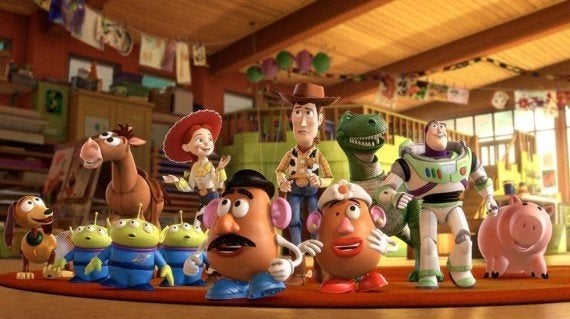
"Toy Story 3" was the highest rated movie of 2010, bringing moviegoers young and old out to the theaters in massive, excitable numbers. An animated film managed to send them home in a haze of emotion, happy to be reunited with their friends and nostalgic at all the time that had passed since the original film -- 16 years!
Now, "Toy Story 3" is the overwhelming favorite for the Best Animated Picture Oscar on Sunday -- not to mention being the third animated movie to be nominated for Best Film -- but not everyone is so sold on its charms. Count animation expert and historian Michael Barrier as a doubter.
An author and widely respected expert in the field, Barrier views "Toy Story," along with its illustrious producers Pixar, not as leading an exciting new frontier in a new Golden Age for cartoons, but instead as creating mechanical, manipulative series of films that don't capture the magic of the yesteryear.
"Animation of any kind is inevitably an industrial process in large part, but I've always felt watching computer animated films and comparing them to hand drawn, there's a stronger sense of the industrial process, the constructions process, in the computer animated films vs. the hand-drawn film," Barrier said. "What I'd call the direct connection between the animator and the character that you have when the animator is drawing the character with a pencil on a sheet of paper, it simply doesn't have an equivalent as far as I'm aware, or if it has an equivalent, it's much harder to establish."
In other words, the soul of the animation has been lost in translation. That, of course, is a question of artistic tastes -- for someone who grew up during an era in which animation truly came of age and flourished, the idea that decades of evolution have been in part rendered moot can be an unwelcome development. While similar principles apply to both kinds of animation, in some ways, the slate was wiped clean in the transition from hand drawn to computer animated, and so the thrill of animation that looks strikingly like our world holds less of an appeal.
That's an aesthetic choice -- though Barrier may be more qualified than most to make that educated judgment, given his encyclopedic knowledge of the medium -- but as a historian, it's about more than what we see now. There's a ceiling on computer animation, he says, with a trajectory that is dwarfed by, well, a certain seven dwarfs.
"If you look back, we've had computer animated features for 16 years going back to 'Toy Story,' and we've had computer animated characters before that, I have not seen the kind of evolution of those characters anything like the extremely compressed and dramatic evolution of the hand drawn characters in the 30s," Barrier observed. "When you think about how Disney went from 'Steamboat Willie' in 1928 to 'Snow White' less than ten years later, I think that's an extremely compressed [growth] that I dont think computer animation has nearly approached. What you have instead in computer animation is a continuing elaboration on texture and surfaces and three dimensional space without anything comparable for characters.
Indeed, Barrier has a point about the rapid growth of animation in the 20's and 30's. "Steamboat Willie," the first Mickey Mouse short, was a quick, music-filled opus that, while dropping the jaws of audiences nationwide at the time of its release, soon seemed like a series of quick sketches by the time Disney began producing its timeless classics. Largely, Woody and Buzz and company looked the same last summer as they did in 1995 -- whether or not that's a bad thing, of course, is another question. The starting point, now, is a bit different than when those great Silly Symphonies began to be shown.
As animation has become more and more main stream, a regular part of our lives, perhaps we've grown less impressed with it, whether it's hand drawn or computer-derived. With that in mind, emphasis has become on story and character -- witness now all the big movie stars voicing characters and increasingly complex plot lines. Animated films such as "Toy Story" have emotional pulls that exceed many live action movies at this point, vaunting them beyond fun niche category. Barrier, though, takes exception with the way that the transition has been made, at least in the way Pixar -- and its ace director, John Lasseter -- has handled it.
"I think they are emotionally manipulative in a fundamentally dishonest way. I dont think the people making the films are necessarily dishonest, but they don't seem attuned to what their stories are saying," the historian alleges. "One example, in the opening montage of 'Up,' you're essentially being strong armed into shedding tears about Carl and Ellie.. to me, it was grotesquely sentimental and a lot of people were looking for an excuse to break into tears, and obviously this was for them. And 'Cars' has, there's a sentimentality in most Pixar pictures that are very manipulative and completely unconvincing to me. They are congratulating their audience for feeling these synthetic emotions and, to me, that's offensive."
As for films of yesteryear that are more organic in their storytelling, Barrier cites "Dumbo" and "Snow White" as two examples. He does allow that "The Incredibles," another Pixar film, had a more honest emotional core, though his praise for the company is few and far between.
As Barrier admits, the trajectory of animation points firmly at an era of computer-created films; while hand drawn can still prosper in places, especially TV, our feature films are moving rapidly away from the Disney classics of yesterday. As with any art form, and especially with film, the merits of that change can be debated; clearly, audiences are responding strongly to the new type of film, and as we become further entrenched in this era, the more normal the new style will seem.
Of course, whether we can look back on the characters created in films today as fondly and universally as we do the Snow Whites and Cinderellas of the world, that will be the great arbiter of new animation's merit. We'll just have to watch and see.
